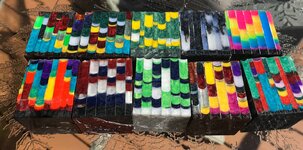Tony
Member
I sell at craft shows fairly regularly and they do okay for me. It's wierd though, I'll sell a dozen in a month and then not sell any for 4 months, then another dozen will. I sell mine for $25, mostly with acrylic or hybrid blanks. Plain wood ones are hard to sell for me, the more colorful they are, the faster they go. They're not practical, I'm in the camp of if you need one you're a quitter, but people like them for gifts. I've done package deals with a vendor friend of mine who sells fabric gift bags for wine bottles, people like that. Not a huge profit in them but it gets people in who then look around at my other stuff that is a bigger money-maker. I only use Niles or Stainless Steel Bottle Stopper products for mine.

